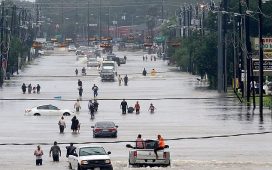Scientists have developed the world’s first real-time map showing the flow of atmospheric rivers in the sky, which transport intense moisture and drive extreme rainfall, an advance that may lead to better flood predictions.
These rivers of wind in the atmosphere are often products of cyclones and determine where intense rain falls and how extreme it could get.
Understanding these weather patterns has become even more crucial in a warming world where the atmosphere tends to soak up greater amounts of water vapour, dumping it later as intense rain.
Until now, detecting atmospheric rivers using satellite observations has been challenging due to a lack of data on winds.
Researchers have now developed an approximate real-time 3D view of winds using satellite records of temperature distributions across several points on the globe.
They combined this data with Nasa’s satellite moisture detection system to reveal a global distribution of atmospheric currents carrying moisture.
Atmospheric river dumps flooding rain on California
Atmospheric rivers carry most of the sky’s moisture across the latitudes as they flow polewards, and are responsible for up to a third of the annual rainfall that the US and Europe gets, and as much as 40 per cent of East Asia’s monsoon.
When these atmospheric rivers laden with moisture hit the skies over land they may lead to extreme weather events such as cyclones or typhoons and flooding.
But previous models to view these rivers overestimated the frequency of rain they produced while underestimating the rain’s intensity.
Now the new model can automatically detect these sky rivers using satellite observations, and provide a much more accurate picture of impending extreme weather events around the world, scientists say.
Researchers used the new detection method to create the world’s first dataset of satellite-based flow of atmospheric rivers, which they say can set a benchmark for nearly the entire globe.
They say the methodology presented in the paper can be applied to other satellite observations to develop even better higher-resolution predictions of atmospheric river flow.












